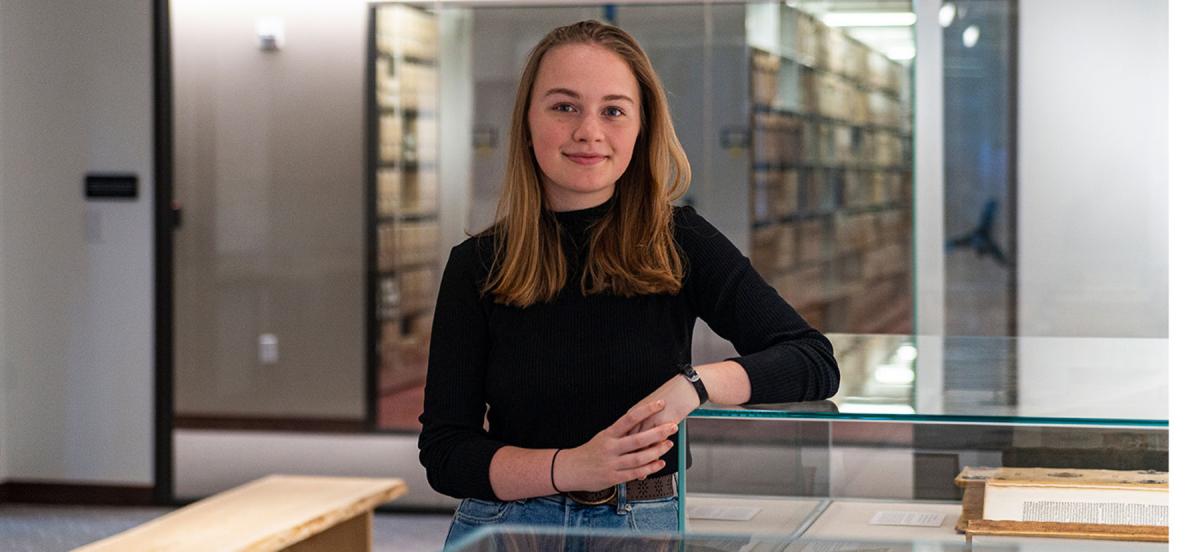Alex Stern '20 Curates Lutnick Library's Inaugural Exhibit

Alex Stern '20 curated the inaugural exhibit in the newly renovated Lutnick Library , featuring items from the David Wertheimer ’77 Collection of Early Printed Books. Photo by Patrick Montero.
Details
The newly renovated library’s first exhibit showcases a new collection of early printed books, hailing from 15th-century Europe.
Though the facilities of Lutnick Library are brand-new, the first books to grace the shelves of the library’s inaugural exhibit will be among some of the oldest in its holdings. The exhibit, which is curated by Alex Stern ’20, showcases the newest addition to the Library’s Quaker and Special Collections, the David Wertheimer ’77 Collection of Early Printed Books.
Donated by Wertheimer, a Haverford alum, the collection contains 55 incunabula, books created immediately following the advent of the printing press in the latter half of the 15th century. Stern’s exhibit, “Who Created the New and Copied the Old:” Printed Books of the Fifteenth Century, will walk visitors through select portions of the new collection.
“I created a survey of what printing looked like in the 15th century,” Stern said, “where the world of books and literature and text was before the first movable-type printing press in Europe opened, and the story of what happened afterwards, guided by the ultimate question of, ‘Did anything really change?’”
For Stern, who double majors in history of art and archaeology, this exhibit isn’t her first curatorial rodeo. In the spring 2019 class “Topics in Exhibition Strategies,” Stern acquired hands-on experience with curation as part of an in-class project, honing the skills she’d already begun to develop as a student intern for Quaker and Special Collections.
“The 15th century and especially the 15th-century Europe isn’t really a place that I spend a lot of time in during the school year,” she said. “So it was fun to try to apply the theory that I study in museum studies to a collection that I had little prior knowledge of beforehand.”
Stern’s exhibit pays close attention to the external features of the books and the process of their creation. Many of the texts, most of which are in Latin, among other European languages, contain detailed illustrations, as well as notes and doodles scrawled in the margins hundreds of years ago.
“It’s important to have the original text as a way of thinking about how people lived and worked throughout the 15th century,” said Sarah Horowitz, the head of Quaker and Special Collections and a guide for Stern during her curatorial work. “We can learn a lot about how people interacted with some of the texts from the physical item.”
Much of the learning that Stern’s exhibit imparts is enhanced by the library’s new Rebecca and Rick White Gallery, a space that the senior has been able to orient to best present her research.
“It’s emblematic of the kinds of work that we have long been doing and which we will be able to do better in the new space,” said Horowitz on the library’s new potential for exhibitions. “Now we have lots of different types of exhibit space and that includes a true gallery space. We’re really excited about what that affords us in terms of the kinds of materials that we can show.”
The collection promises to keep yielding learning opportunities even after Stern’s exhibit, which will run from October 7 through February 16, concludes. Several classrooms in the library are equipped to offer students hands-on time with the historic texts (as well as other materials from Special Collections) in class.
“It’s exciting to think of the kinds of curricular projects we could do later following from Alex’s work in the exhibit, the different ways that students could use the materials,” said Horowitz.
Among the impressive array of incunabula donated by Wertheimer, are copies of the Liber Chronicarum, which Stern called “the first coffee table book of Europe,” and a text by the classical historian Livy that was held in a monastery library centuries ago. Though books are only growing older, they promise to keep providing learning opportunities for future students, whether its from Stern’s exhibit or beyond.
“In some ways this is a really transformative collection for us,” said Horowitz. “We have a few incunabula in the collection. Having David’s collection really transforms what we’re able to do when we talk about early printing here at Haverford, so we’re excited about the possibilities that abound from that.”






